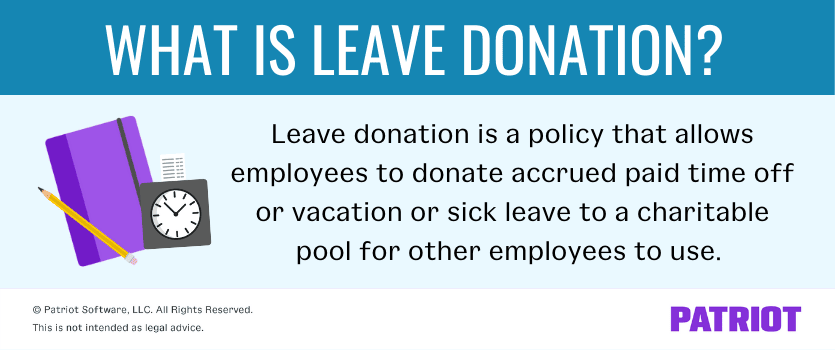When it comes to running a business, you’re constantly looking for new ways to boost employee morale and increase employee retention. One solution? Letting employees donate PTO by creating a leave donation program. But, what is leave donation, exactly? And, how does it work when it comes to taxes?
What is leave donation?
Leave donation, or leave sharing, is a policy that allows employees to donate accrued paid time off or vacation or sick leave to a charitable pool or bank for other employees to use.
After employees donate their unused paid time off, sick leave, or vacation time, employers can then use that leave bank to make donations to eligible employees or qualifying charities under section 107(c).
Employees can use the leave to take time off for unexpected events if they’re out of available paid leave. For example, an employee may dip into the leave share pool when they run out of PTO to take time off for a medical emergency.
Or, you can use the leave bank to make donations to qualifying charities. You can then deduct these cash payments as a business expense or as a charitable contribution donation. For example, employees could donate PTO in response to the COVID-19 pandemic, the 2022 further Russian invasion of Ukraine, and the 2023 Hawaii wildfires.
The type of leave employees can donate may vary from state to state. Each state has different rules regarding an employee’s right to certain kinds of leave and what kind of leave employees can donate to a leave donation program. Check with your state for more information on leave sharing rules.

What are the benefits of leave donation?
There are several reasons why employers may adopt a leave sharing program. A leave sharing program can:
- Enhance employee morale
- Increase productivity
- Reduce absenteeism
- Improve recruiting
- Retain employees
Can employees donate PTO?
Yes, employees can donate PTO if you have a leave donation program in place.
But when it comes to leave sharing and taxes, any leave earned by one employee and donated to another is still taxable for both employees. However, the IRS has two exceptions to this rule which allow employees to donate leave without negative tax consequences to the employee donating their time:
- Medical emergency: For fellow employees who have experienced a medical emergency or need to care for a family member.
- Major disaster: For fellow employees or charities that have been affected by a natural disaster or other emergency declared by the president.
Under both medical emergency and major disaster plans, donor employees cannot claim an expense, tax deduction, or charitable contribution for any of the leave donated.
Each exception has specific requirements employers and employees must follow.
Medical emergency leave donation
An employee can donate excess paid leave to another employee in the event of a medical emergency. A medical emergency is defined as:
A medical condition of the employee or a family member that will require the prolonged absence of the employee from duty and will result in a substantial loss of income to the employee because the employee will have exhausted all paid leave available apart from the leave sharing plan.
Generally, an employee who has exhausted paid leave may draw from the leave bank if they need more time off if they:
- Experience a medical emergency
- Need to tend to a parent, spouse, or child with a medical emergency
- Need additional time off for bereavement for the death of a parent, spouse, or child
For an employer-sponsored leave sharing program for medical emergencies, the plan should:
- Be in writing and administered by the employer
- Be created as a leave bank or pool for employees to deposit donated leave, and from which, leave will be distributed to recipients who have a personal or family medical emergency
- State that employees should be eligible to receive leave only after their request has been approved and all other available paid leave has been exhausted
- Specify that leave is to be used only for qualified medical emergencies (including bereavement in some cases)
- Outline and specify limits on the amount of leave that may be donated by an individual in any given year
- Have a detailed procedure for employees to submit a written request for leave that describes the specific medical emergency or medical condition
- Have processes to confirm that all leave transferred under the plan is actually being used for medical leave by the recipient
Major disaster leave donation
The IRS defines a major disaster as:
A major disaster as declared by the President under § 401 of the Stafford Act, 42 U.S.C., section 5170, that warrants individual assistance or individual and public assistance from the federal government under that Act or a major disaster or emergency as declared by the President pursuant to 5 U.S.C., section 6391, in the case of employees described in that statute.
Once the president declares a major disaster (e.g., COVID-19), the IRS allows leave donations to employees affected by the disaster or qualifying charities without negative tax consequences.
An employer-sponsored leave sharing program for major disasters must meet the following requirements:
- Plans must be in writing
- The plan must allow a leave donor to deposit unused accrued leave in an employer-sponsored leave bank for the benefit of other employees who have been adversely affected by a major disaster
- The plan does not allow a donor to specify a particular recipient of their donated leave
- The amount of leave donated in a year may not exceed the maximum amount of leave that an employee normally accrues during that year
- A leave recipient may receive paid leave from the leave bank at the recipient’s normal compensation rate
- The plan must provide a reasonable limit on the period of time after the disaster has occurred, during which leave may be donated and received from the leave bank, based on the severity of the disaster
- A recipient may not receive cash in lieu of using the paid leave received
- The employer must make a reasonable determination of the amount of leave a recipient may receive
- Leave deposited on account of a particular disaster may be used by only those employees affected by that disaster.
- Any donated leave that has not been used by recipients by the end of the specified time must be returned to the donor within a reasonable time so that the donor may use the leave
- The amount of leave returned must be in the same proportion as the leave donated.
For more information, check out IRS Notice 2006-59.
How to create a leave donation program
Before creating a leave sharing policy, weigh the pros and cons of the plan for your business. If you decide to go the leave-based donation program route, consider the following tips.
1. Create a written policy
Create a written policy that outlines the program and application process for employees who want to use leave.
Your written policy should outline:
- Employee eligibility for using donated leave
- Employees who can share leave
- Steps to donate leave to the pool/bank
- Requirements to use donated leave (e.g., medical emergency)
- Maximum amount employees can donate
- Total amount a donor employee can take from the pool
- Value of donated leave (i.e., recipient’s rate of pay)
- Time frames for use of leave
- Proof of qualified leave
- Tax rules
- Other rules and requirements
2. Understand IRS guidance
Employees who donate leave for qualifying medical emergencies or major disasters do not have to pay taxes on their donated PTO.
Don’t include the amount of qualified leave-based donation payments on a donating employee’s Form W-2. The recipient is taxed as if they earned the PTO.
Keep in mind that employees also cannot claim their contributions as charitable deductions. However, employers can deduct cash payments made to victims of natural disasters or emergencies as a business expense or charitable contribution deduction.
3. Do not create a program only when an employee has an issue
If you want to create a leave donation program, do so before an employee has a qualifying issue. Otherwise, you could be accused of favoritism or discrimination.
4. Keep information private
Do not share personal information about the recipient, such as what medical issues they are having. Also, do not share donor information.
Keep all information about both donors and recipients private.
5. Notify employees
Once you establish a PTO donation plan, let employees know how they can participate if they’re eligible. Reiterate that donating PTO is voluntary.
And, consider having each employee sign a leave donation form to ensure they know and understand the plan’s rules.
Keep the form in your employee records for safekeeping and easy access.
On the hunt for an easy way to track your employees’ paid time off, vacation, and more? Patriot’s time and attendance software add-on and payroll are a perfect match. Track and manage employee time, view and approve timesheets, and more. Try both for free today!
This article is updated from its original publication date of June 14, 2012.
This is not intended as legal advice; for more information, please click here.



